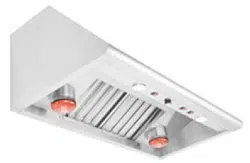Loading ...
Loading ...
Loading ...

11
PLANNING THE INSTALLATION
BACKDRAFT DAMPER:
We recommend that a backdraft damper be used in all Vent Hood installations. Cold weather installations necessitate
the use of a back-draft damper to minimize the flow of cold air into the room. A nonmetallic thermal break should also
be installed to minimize conduction of outside temperatures through the ductwork. Locate the thermal break as close
as possible to where the ducting enters the heated portion of the house.
PLANNING THE INSTALLATION:
Before beginning installation of the Vent Hood and Ventilator, PLAN OUT the entire installation procedure beforehand,
considering the following areas:
1. HOOD SIZE & LOCATION – The hood should be as wide or wider than the cooking appliance with the
hood being centered on the appliance. Vertically, the bottom of the hood should be between 30”-36” above
the appliance cooking surface.
2. DUCTING – ducting transitions, air flows to outside? Use of Back-draft damper?….etc.
3. ELECTRICAL REQUIREMENTS – 120 Volts, 60Hz, 15 AMP Service, local codes….etc.
4. ADEQUATE MOUNTING SURFACES – Location of wall studs, additional support for safe wall mounting….etc.
HANDLING NOTE: This hood has been inspected prior to shipping to be free of defects. Due to the weight of the
Vent Hood and Ventilator and to prevent scratching or denting the unit, we recommend the use of two installers to
move, place, and secure the Vent Hood to avoid personal injury or damage to the hood.
MODEL IDENTIFICATION:
PSVH24 PSVH30 PSVH36 PSVH48 PSVH60
PSVH36HL PSVH48HL PSVH60HL
When planning an installation within an enclosure outside the house, in addition to the standard installation
instructions the following construction and installation recommendations should be followed:
1. The location of the hood must be planned to prevent direct or indirect exposure to water spray
(with the exception of fire suppression devices)
2. All framing and soffit construction must be of non-combustible materials.
3. All wall surface construction materials and finishes must be of non-combustible materials.
4. All electrical connections must have ground fault interruption (GFI) protection.
5. External venting of the hood must be properly planned and capped to prevent the
entrance of water into the ducting system.
6. Fasteners approved for moist environments are recommended when mounting the hood.
INSTALATION IN ENCLOSED OUT DOOR ENVIRENMENT
Loading ...
Loading ...
Loading ...
